Perfect Hard Boiled Eggs (Easy Peel)
How to Hard Boil Eggs—Learn step-by-step the best way to make hard-boiled eggs that are easy to peel and have perfect, firm, and silky yolks every time!
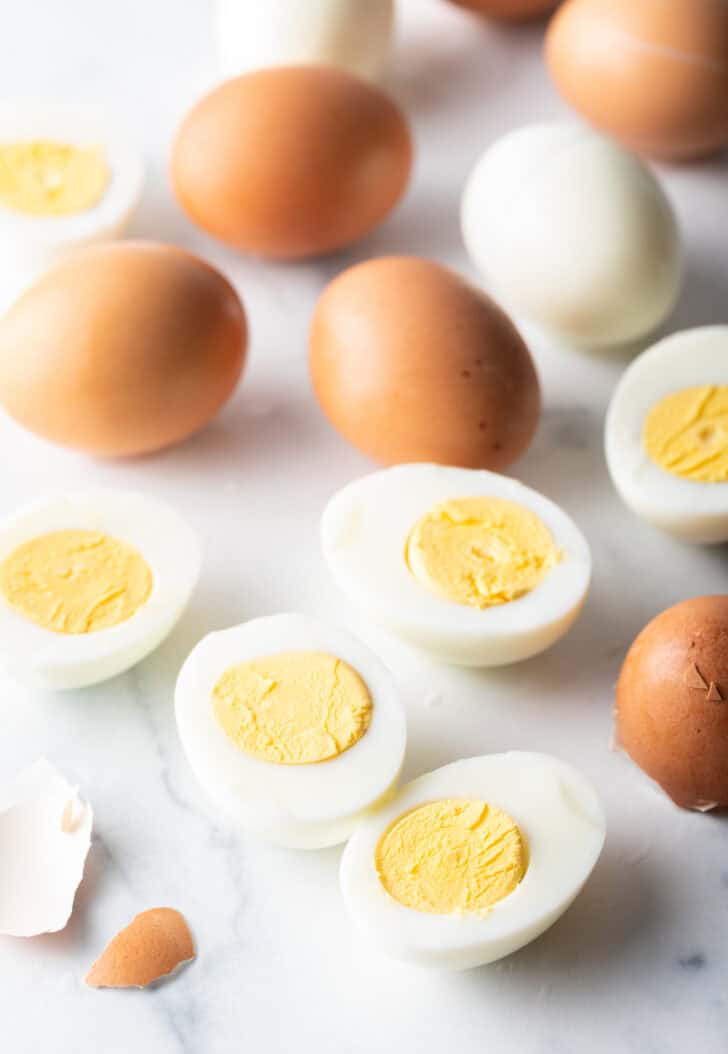
Why We Love This Easy Hard Boiled Eggs Recipe
Classic hard boiled eggs are one of those must-have recipes for all home chefs, regardless of skill level or how often you cook. After literally years of testing and tweaking methods, we’re thrilled to share with you our go-to way to make Perfect Hard Boiled Eggs that are actually easy to peel!
We walk you through the entire foolproof process of hard-boiling eggs, including the best tips to know before getting started and top tricks for peeling the perfect egg. With these easy steps, you’re practically guaranteed to boil eggs with a firm and tender yellow yolk – no green rings here!
These versatile hard boiled eggs are delicious to use in salads, grab as a healthy snack or breakfast on the go, and include in all kinds of savory dishes. Boil up a dozen now and enjoy all week long, whenever you need a scrumptious and nutritious boost of protein!
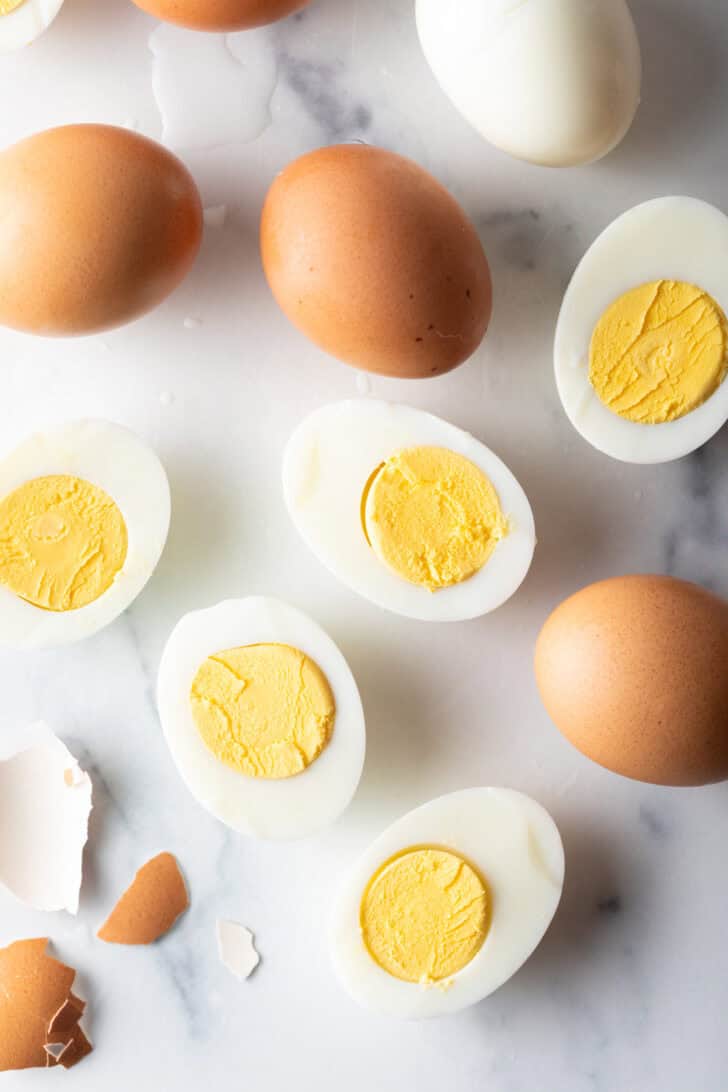
Before Getting Started – Tips for Hard Boiling Eggs
Knowing a few simple tricks before beginning to hard boil your eggs can help ensure they come out perfectly done and super easy to peel!
- Start with older eggs – When eggs have been sitting in the fridge longer, the shell and cooked egg inside separate more easily.
- Add an acidic ingredient to the water – Adding a little splash of vinegar or lemon juice helps soften and loosen the egg white from the shell while boiling.
- Prep the ice – Get a bowl of ice water ready while the eggs are boiling.
- Crack then shock – Gently crack the eggs before resting and ice water. This allows a little water to seep in between the shell and egg layer.
- Yes, definitely shock – Shocking the eggs and ice water after cooking stops the egg yolk from cooking too much inside the eggs (creating the dreaded gray ring), and makes the shells much easier to peel off.
- “Wash” then dry – Rinse the egg and cold water after peeling to make sure you’ve removed every bit of eggshell debris. Then gently pat the eggs dry with a clean lint-free paper towel or dishtowel.

Ingredients and Equipment You Need
- Eggs – use large eggs at room temperature
- Vinegar – distilled white vinegar is best
- Water – just enough to cover the eggs in the pot
- Ice – use small cubes of ice to cool the eggs quickly
You want to hard boil the eggs in a large, deep cooking pot so they aren’t overlapping. They can touch, like in the pictures below – and this helps them from bouncing around a bunch in the pot – but the pan shouldn’t be overcrowded.
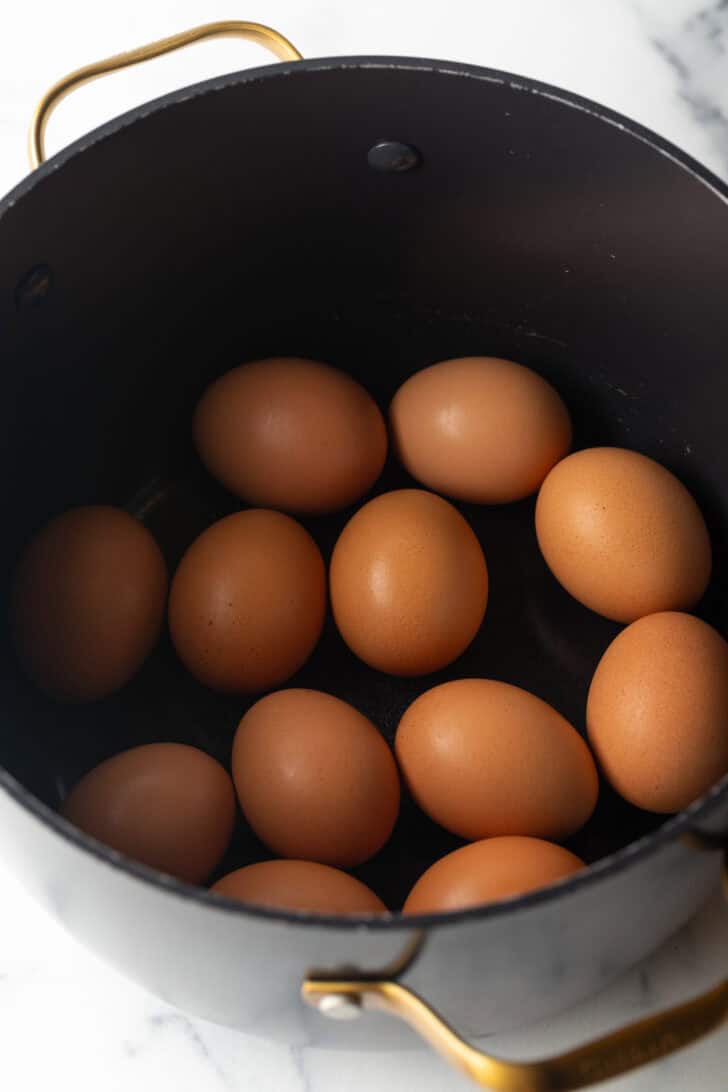
Step-By-Step How to Make Hard Boiled Eggs
- Place the eggs in a medium sauce pot. It’s ok if they touch, but they should not overlap. Carefully pour cold water over the eggs until the water level reaches 1 inch above the top of the eggs. Then, pour in the vinegar or lemon juice.
- Place the pot over high heat and bring the water to a boil. The moment the water starts boiling set the timer for 9-12 minutes…
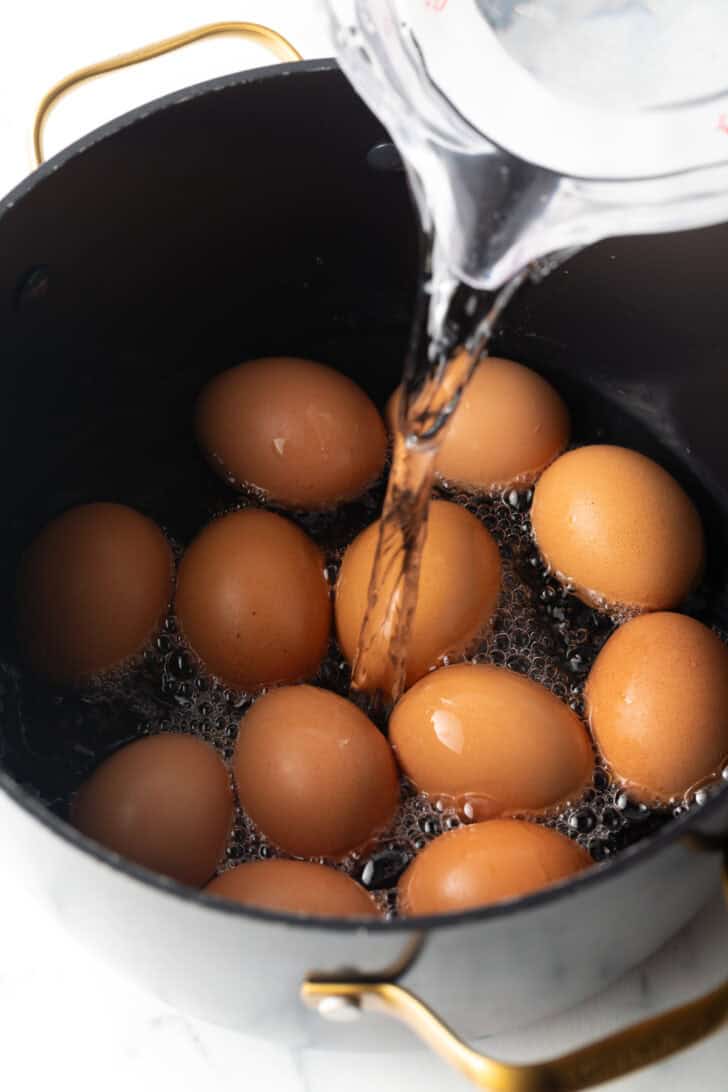
How Long to Hard Boil Eggs
If you want your hard boiled eggs to be soft boiled with a cooked but slightly softer jammy, custard-like interior, stop the cooking process at 9-10 minutes.
If you want your hard boiled eggs to be fully cooked and firm throughout, boil in the saucepan for 12 minutes.
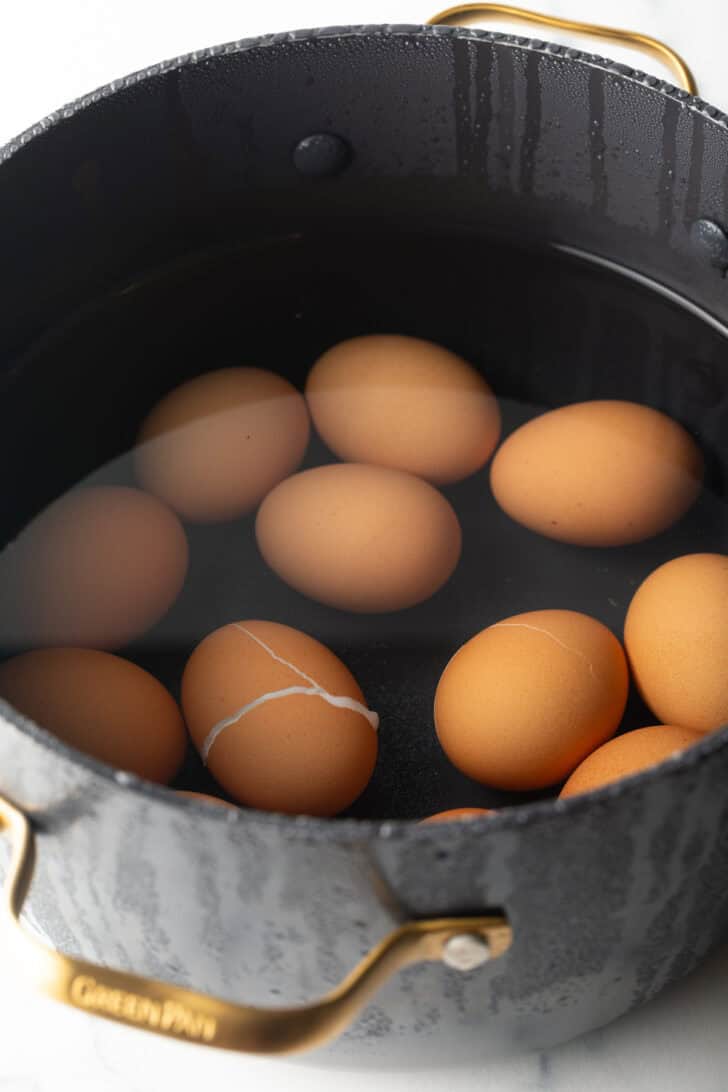
- Once the timer goes off, remove the pot from heat and quickly fill the pot with ice to bring the temperature of the eggs down and stop them from cooking. Dump off some of the cold water if needed, then add more ice.
Allow the eggs to cool, shocking them for at least 25-30 minutes before peeling.
Pro Tip: Do not boil longer. Overcooked yolks often form a grayish-green ring around the yolk. It’s safe to eat, but not very attractive.
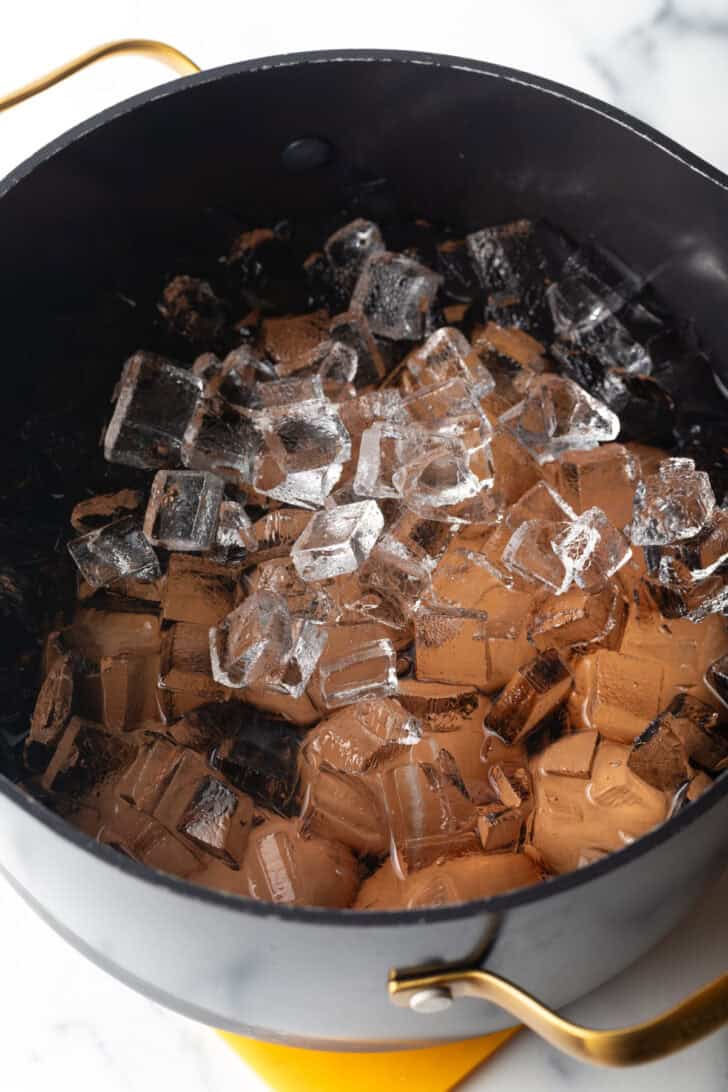
Some of the eggs might have cracked while cooking. The eggs cracking is actually a good thing, and makes it easier to peel later! In fact…
- Once the water is cool enough for you to put your hand in, gently tap the uncracked eggs on the bottom of the pot to create a crack. This will allow water to enter under the shell while cooling.
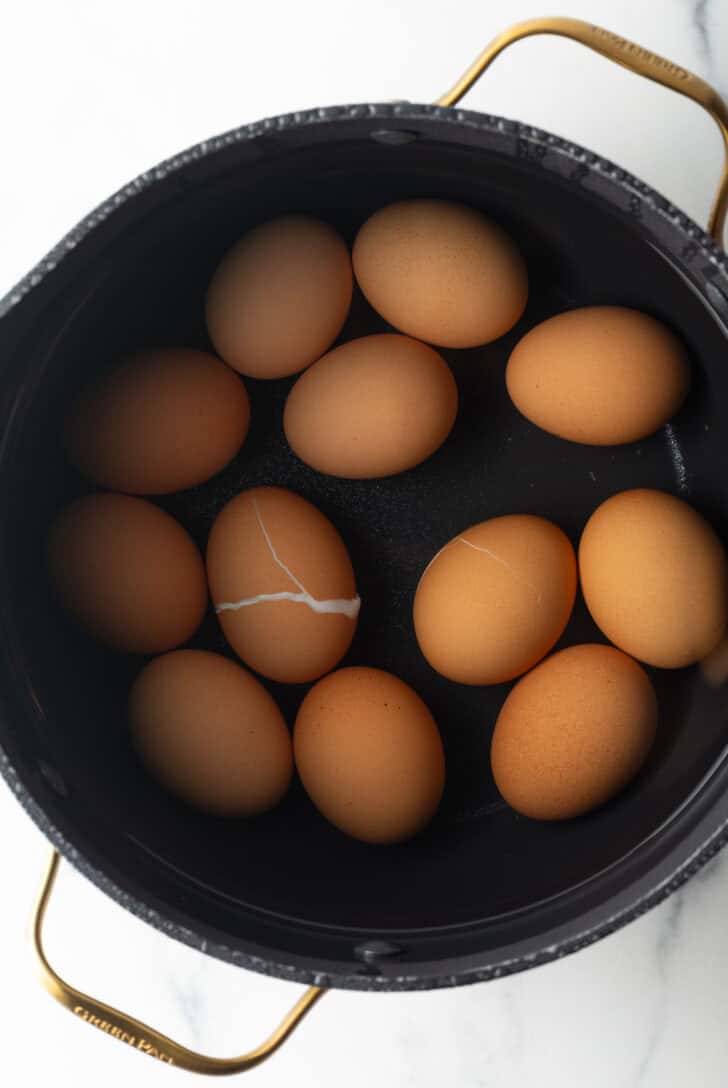
- Remove the eggs from the ice water, and follow these easy steps to remove the shell:
- Gently tap the eggs and roll on a hard surface to continue cracking the shell.
- Remove a section of eggshell that’s the most obvious opening.
- Then, use the opening to peel off larger sections of the eggshell.
- Once all the eggs are peeled, rinse them in water to remove any debris.
Get the Complete (Printable) Guide for How to Make Hard Boiled Eggs Below + Video. Enjoy!
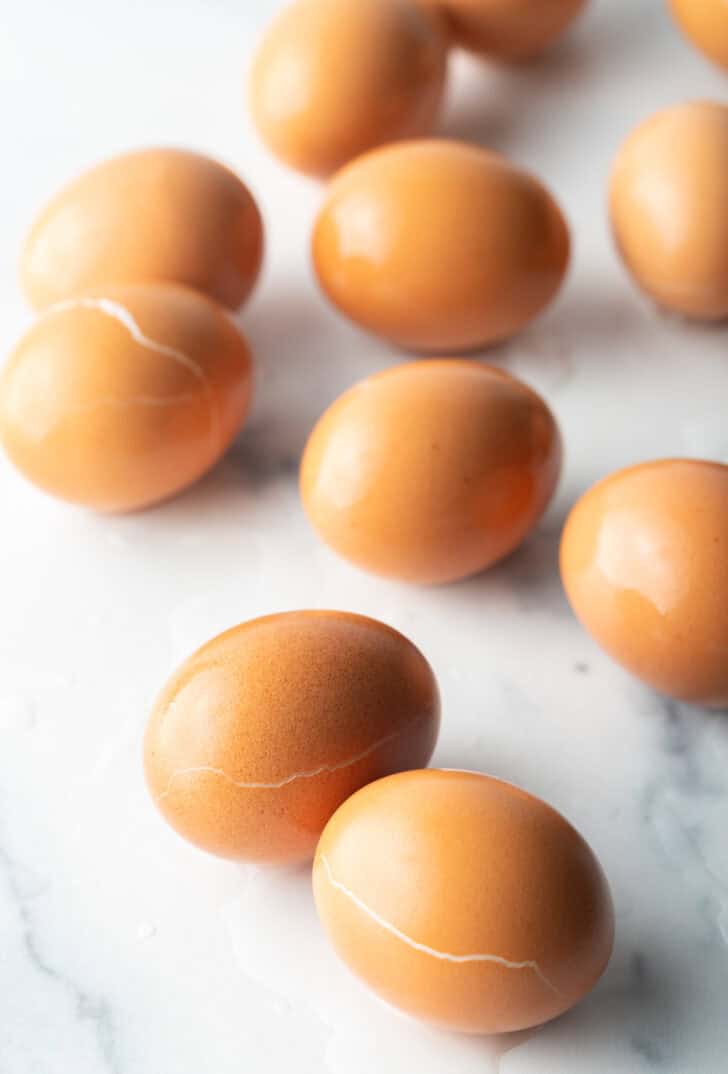
Best Tips for How to Peel Hard Boiled Eggs
- Don’t overcook hard boiled eggs – Take the pot of off the heat as soon as the water just begins to boil. Do not wait until the water comes to a rolling boil, or they’ll crack too much too soon.
- Cool them quickly – The ice bath shocking process stops the eggs from overcooking, and helps to keep the shells from sticking to the egg whites. Don’t skip using ice!
- Tap them in water – Lightly cracking the eggs a bit while they are still cooling in the water lets some of that water get into the egg. Cooling them fast and letting in water pushes the shell away from the firm whites, so it practically pops off.
- Roll the eggs – …But not too much! Place a hard-boiled egg sideways on a clean countertop. Then, use the palm of your hand to gently roll the egg back and forth. Use light pressure so you aren’t squishing the egg, but light cracks form across the shell.
- Lift up as you peel – When you are peeling the eggs, try to get the tips of your thumbs and fingers under the shell and peel up and away. If you try rubbing the shell away or peeling with your nails, you run the risk of digging into the egg and removing large chunks of egg white.

Suggestions for What to Do with Hard Boiled Eggs
I mean, really, there are SO many ways to use this delicious and versatile protein-packed powerhouse! Where do we even begin?
Let’s start with the first meal of the day: Hard boiled eggs are brilliant to have on hand for a quick breakfast by themselves, on Avocado Toast or on a Breakfast Salad (yup, it’s a thing and it is SO good!).
Then it’s on to lunchtime, picnics, and potlucks with these classic cold and creamy salad recipes:
- Deviled Egg Potato Salad
- Creamy Deviled Egg Pasta Salad
- Best Potato Salad Recipe Ever (Seriously)
- And egg salad for egg salad sandwiches, of course!
Speaking of deviled eggs… This recipe is great as a base for making all kinds of deviled eggs, with some twists!
- Avocado Deviled Eggs with Bacon and Pomegranate
- Deviled Eggs with Capers AKA Angel Eggs
- Pimento Cheese Deviled Eggs
Firm and tender hard-boiled eggs are also fabulous to add on top of crunchy, cold, and refreshing salads and bowls, like:
They are also delicious for adding extra protein to warm savory dishes, like ramen noodles! Here are a few of our favorites:
- Spicy Shrimp Ramen
- Spicy Vegan Ramen
- Spicy Kimchi Ramen Bowl
- Chicken Katsu Ramen
- Slow Cooker Chicken Ramen Noodles
And other flavorful dishes like Chilaquiles with Marinated Skirt Steak, Chicken Congee (Jook Rice Porridge),
If you want a SUPER fun, delicious and exciting way to use hard boiled eggs you’ve got to try this Spicy Beet Pickled Eggs recipe!
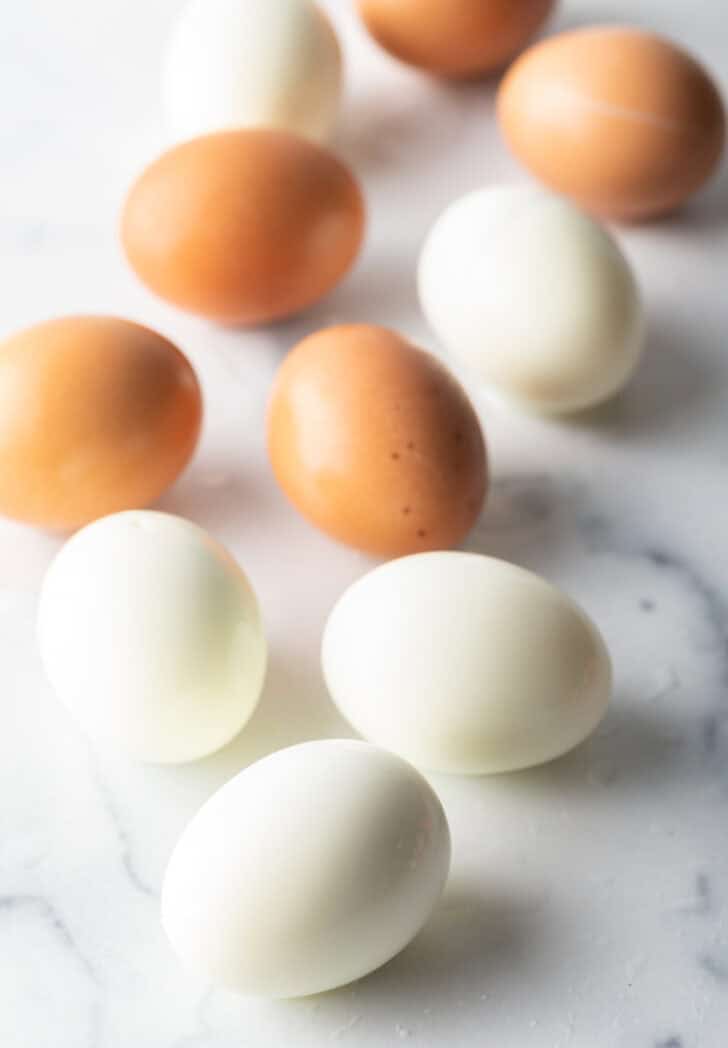
Frequently Asked Questions
No, you always want to start with cold water to make perfect hard boiled eggs. Adding them to hot water will overcook them, so you can avoid the dreaded green ring in the yolk.
The best way to store hard-boiled eggs is in an airtight container to prevent odors from entering. If stored well, they will keep for up to a week in the refrigerator.
Either way is acceptable, but eggs with the shells left on will keep well for a few days longer.
Yes, this is a great hard boiled egg recipe for dying Easter eggs!
If you plan to dye the eggs after boiling, DO NOT crack them in the water. Also, be sure to let the eggs cool completely and dry well before dying them.
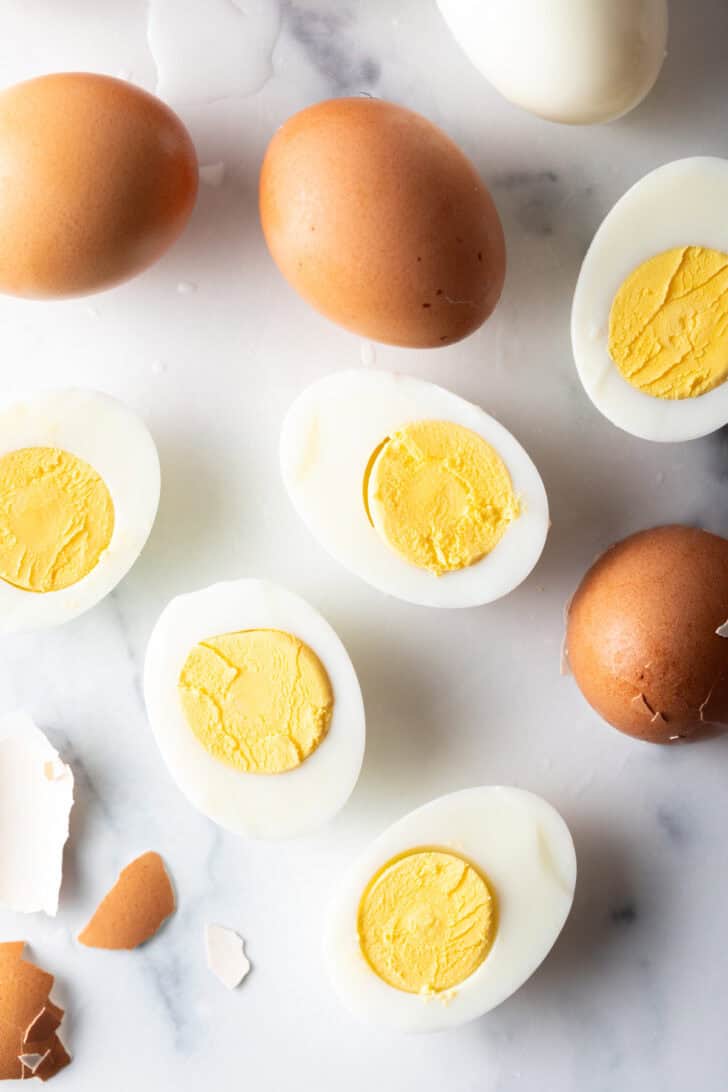
Looking for More Egg-cellent Recipes? Be Sure to Try:
- How to Scramble Perfect Fluffy Eggs
- How to Make Ramen Eggs
- Easy Egg Bites Recipe
- How to Make Over Easy Eggs
- Easy Eggs Benedict Casserole
- Egg White Frittata with Spinach
- Vietnamese Egg Coffee
- Homemade Egg Drop Soup
Perfect Hard Boiled Eggs (Easy Peel!)
Video
Ingredients
- 12 eggs
- 1 tablespoon vinegar or lemon juice
- Water
- Ice
Instructions
- Place the eggs in a medium sauce pot. Cover the eggs with cold water, until the water level reaches 1 inch above the top of the eggs. Pour in 1 tablespoon of vinegar or lemon juice.
- Place the pot over high heat. Bring the water to a boil. The moment the water starts boiling set the timer for 9-12 minutes.If you want your hard boiled eggs to be soft boiled with a cooked but slightly softer custard-like interior, stop the cooking process at 9-10 minutes. If you want your hard boiled eggs to be fully cooked through, boil for 12 minutes.
- Once the timer goes off, remove the pot from heat and quickly fill the pot with ice to bring the temperature of the eggs down and stop them from cooking. *Do not boil longer. Overcooked yolks often form a grayish-green ring around the yolk. It’s safe to eat, but not very attractive.Dump off some of the cold water if needed, then add more ice. Allow the eggs to cool, shocking them for at least 25-30 minutes before peeling.
- Some of the eggs might have cracked while cooking. This is actually a good thing, and makes it easier to peel later. Once the water is cool enough for you to put your hand in, gently tap the uncracked eggs on the bottom of the pot to create a crack. This will allow water to enter under the shell while cooling.
- Remove the eggs from the ice water. Gently tap the eggs on a hard surface to continue cracking the shell. Remove a section of eggshell that’s the most obvious opening. Then use the opening to peel off larger sections of the eggshell.
- Once all the eggs are peeled, rinse them in water to remove any debris.
- Either serve the eggs, or place them in an airtight container and keep refrigerated until ready to use. Hard boiled eggs will keep for up to a week if stored well.
Notes
- Start with older eggs. When eggs have been sitting in the fridge longer the shell and cooked egg inside separate more easily.
- Add an acidic ingredient to the water. Adding a little splash of vinegar or lemon juice helps soften and loosen the egg white from the shell while boiling.
- Gently crack the eggs before resting in ice water. This allows a little water to seep in between the shell and egg layer.
- Shock the eggs in ice water after cooking. This not only stops the egg yolk from cooking too much inside the eggs (creating the dreaded gray ring) but makes the shells much easier to peel off.
- When ready to peel, gently roll the eggshell on a solid surface to create small cracks around the egg. Then peel back one bit, and use the opening to peel off larger sections of the eggshell. Rinse the egg and cold water after peeling to make sure you’ve removed every bit of eggshell debris.

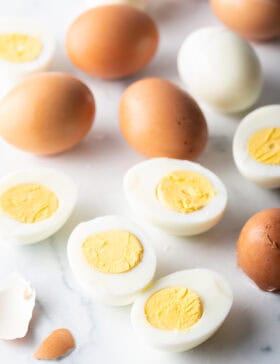

Absolutely perfect! I followed the steps exactly, and the eggs turned out flawless
I’ve tried so many methods for hard boiled eggs, and this one finally nailed it. The eggs were cooked just right, and the shells practically slid off. Highly recommend for anyone who’s struggled like I have!